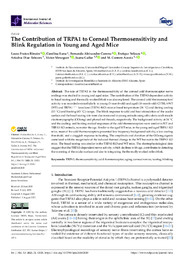Por favor, use este identificador para citar o enlazar este ítem:
https://hdl.handle.net/11000/35406Registro completo de metadatos
| Campo DC | Valor | Lengua/Idioma |
|---|---|---|
| dc.contributor.author | Frutos-Rincón, Laura | - |
| dc.contributor.author | Luna, Carolina | - |
| dc.contributor.author | Aleixandre-Carrera, Fernando | - |
| dc.contributor.author | Velasco, Enrique | - |
| dc.contributor.author | Díaz-Tahoces, Ariadna | - |
| dc.contributor.author | Meseguer, Víctor | - |
| dc.contributor.author | Gallar, Juana | - |
| dc.contributor.author | Acosta Boj, María del Carmen | - |
| dc.contributor.other | Departamentos de la UMH::Fisiología | es_ES |
| dc.date.accessioned | 2025-01-28T18:14:38Z | - |
| dc.date.available | 2025-01-28T18:14:38Z | - |
| dc.date.created | 2023-08-09 | - |
| dc.identifier.citation | Int J Mol Sci . 2023 Aug 9;24(16):12620 | es_ES |
| dc.identifier.issn | 1422-0067 | - |
| dc.identifier.uri | https://hdl.handle.net/11000/35406 | - |
| dc.description.abstract | The role of TRPA1 in the thermosensitivity of the corneal cold thermoreceptor nerve endings was studied in young and aged mice. The contribution of the TRPA1-dependent activity to basal tearing and thermally-evoked blink was also explored. The corneal cold thermoreceptors' activity was recorded extracellularly in young (5-month-old) and aged (18-month-old) C57BL/6WT (WT) and TRPA1-/- knockout (TRPA1-KO) mice at basal temperature (34 °C) and during cooling (15 °C) and heating (45 °C) ramps. The blink response to cold and heat stimulation of the ocular surface and the basal tearing rate were also measured in young animals using orbicularis oculi muscle electromyography (OOemg) and phenol red threads, respectively. The background activity at 34 °C and the cooling- and heating-evoked responses of the cold thermoreceptors were similar in WT and TRPA1-KO animals, no matter the age. Similar to the aged WT mice, in the young and aged TRPA1-KO mice, most of the cold thermoreceptors presented low frequency background activity, a low cooling threshold, and a sluggish response to heating. The amplitude and duration of the OOemg signals correlated with the magnitude of the induced thermal change in the WT but not in the TRPA1-KO mice. The basal tearing was similar in the TRPA1-KO and WT mice. The electrophysiological data suggest that the TRPA1-dependent nerve activity, which declines with age, contributes to detecting the warming of the ocular surface and also to integrating the thermally-evoked reflex blink. | es_ES |
| dc.format | application/pdf | es_ES |
| dc.format.extent | 19 | es_ES |
| dc.language.iso | eng | es_ES |
| dc.publisher | MDPI | es_ES |
| dc.rights | info:eu-repo/semantics/openAccess | es_ES |
| dc.rights | Attribution-NonCommercial-NoDerivatives 4.0 Internacional | * |
| dc.rights.uri | http://creativecommons.org/licenses/by-nc-nd/4.0/ | * |
| dc.subject | TRPA1 | es_ES |
| dc.subject | aging | es_ES |
| dc.subject | blinking | es_ES |
| dc.subject | cold thermoreceptor | es_ES |
| dc.subject | corneal nerves | es_ES |
| dc.subject | tearing | es_ES |
| dc.subject | thermosensitivity | es_ES |
| dc.title | The Contribution of TRPA1 to Corneal Thermosensitivity and Blink Regulation in Young and Aged Mice | es_ES |
| dc.type | info:eu-repo/semantics/article | es_ES |
| dc.relation.publisherversion | 10.3390/ijms241612620 | es_ES |

Ver/Abrir:
The contribution of TRPA1 to corneal.pdf
2,21 MB
Adobe PDF
Compartir:
 La licencia se describe como: Atribución-NonComercial-NoDerivada 4.0 Internacional.
La licencia se describe como: Atribución-NonComercial-NoDerivada 4.0 Internacional.
.png)